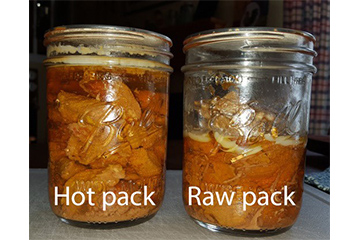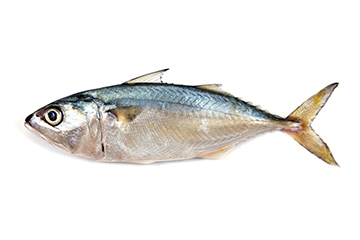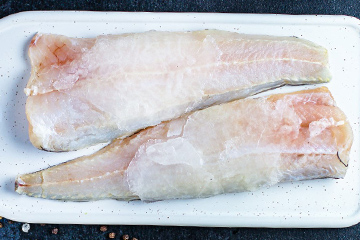
Shop Local and Preserve It Safe

Due to supply and demand issues caused by the COVID-19 pandemic, many consumers are reaching out to local food producers to fill their refrigerators and freezers with meat as well as many other food items. This is a great way to support local farmers and producers and to stimulate local economies.
For those shopping from local meat producers for the first time, it is important to be an informed buyer. Consider what cuts of meat your family enjoys and how much storage space is available. Work with the producer and processor to get the cuts you want. Learn more about local meat processing at http://enewsletters.k-state.edu/youaskedit/2020/02/12/what-to-expect-when-processing-meat/.
Small meat processors will freeze the meat. Be sure to inspect the packages for damage or vacuum seal leaks. If you are short on freezer space, consider canning your domestic meat or wild game purchases.
You must use a pressure canner to can meat, since it is a low-acid food with a pH of higher than 4.6. Pressure canning allows the temperature to reach 240–250 degrees F; this temperature, coupled with the proper amount of processing time, will make a safe, shelf-stable product.
Previously frozen meat must be completely thawed before you can it. Place the meat on a large tray on the bottom shelf of your refrigerator.
Make sure no ice crystals remain before you can the meat, though it should be canned within two days after thawing. Can fresh refrigerated meat within two days of purchase or processing.
Various small meat cuts can be safely canned. Options include ground meat; strips, cubes or chunks; meat stock; and meat and vegetable soup. Chicken and rabbit also can be canned with or without bones. Be sure to use very lean meat. While fat adds flavor, excess fat can climb up the sides of the jar and interfere with the seal. Do not add the giblets if you’re canning poultry, as their flavor will overpower the poultry meat. Salt adds flavor but may be omitted. For chicken, rabbit or meat in strips, cubes or chunks, the raw pack method to fill jars may be used. Do not add liquid. The meat will shrink after processing, leaving excess space. The hot pack method gives a better quality product and allows more meat in the jar.
There are no researched instructions for canning cured, brined or corned meats. The USDA Complete Guide to Home Canning provides instructions for fresh meat only. For more recipe resources, see K-State’s food preservation recipe page (https://www.rrc.k-state.edu/preservation/recipes.html) and MU Extension’s Food Preservation website (https://extension.missouri.edu/programs/food-preservation).
Preserving Fish

You also can store food for future use by preserving freshly caught fish with home canning or freezing.
To home preserve fish by canning
To prepare fish for home canning, you must remove the guts at once, put the fish on ice immediately after you catch it and can the fish within two days.
Fish is a low-acid food and can be processed safely only at temperatures reached in a pressure canner.
If the fish is frozen, thaw it before canning. Rinse the fish in cold water. You can add 2 tablespoons of vinegar per quart of water to help remove any slime. Remove the head, tail, fins and scales; it is not necessary to remove the skin. You can leave the bones in most fish because the bones become very soft and are a good source of calcium. Wash the fish and remove all blood. Refrigerate all the fish until you are ready to pack it in jars.
If you are using pint jars, cut the cleaned fish into 3½-inch lengths. If the skin has been left on the fish, pack the fish skin outward for a nicer appearance or skin inward for easier jar cleaning. Pack the fish solidly into hot jars, leaving 1 inch of headspace. If you would like firm-packed fish, run a plastic knife around the inside of the jar to align the product. Add 1 teaspoon of salt per pint, if desired. Do not add liquids. Carefully clean the jar rims and wipe them dry to remove any fish oil. Adjust the lids, and process for 100 minutes at 11 pounds pressure.
If you are using quart jars, cut cleaned fish into jar-length fillets or chunks of any size. Pack the fish solidly into hot jars, leaving 1 inch of headspace. Add seasonings or salt for flavor, according to your preference. Do not add liquids.
Carefully clean the jar rims and wipe them dry to remove any fish oil. Adjust lids, and process for 160 minutes at 11 pounds pressure.
For safety’s sake, you must have a complete, uninterrupted 160 minutes (2 hours and 40 minutes) to process at the minimum pressure required for your altitude. At the beginning of the process, write down the time it began and the time the process will be finished.
These instructions are for blue, mackerel, salmon, steelhead, trout and other fatty fish, except tuna. Glasslike crystals sometimes form in canned salmon (these are magnesium ammonium phosphate). There is no way for the home canner to prevent these crystals from forming, but they usually dissolve when heated and are safe to eat.
To preserve fish by freezing

Freeze only fresh fish. Cut and package the fish into meal-size portions. Use heavily waxed paper, freezer wrap, heavy-duty aluminum foil or plastic freezer storage bags for fish storage. Wrap the fish tightly. Remove all air from the bag before sealing it. Label your packages with their contents and the date. Space the packages in the freezer to allow proper air circulation for cooling and freezing. Once the packages are solidly frozen (within 24 hours), you can restack them within the freezer. You can store properly wrapped lean fish for six months and fatty fish for two–three months in the freezer.
Note:
Fish can be placed in a shallow metal plan, covered with water, frozen and rewrapped in foil, paper or plastic for freezing.
Source:
National Center for Home Food Preservation. 2018. “Selecting, Preparing and Canning Meat: Fish.” Last reviewed February 2018. https://nchfp.uga.edu/how/can_05/fish.html.